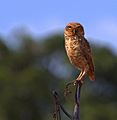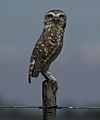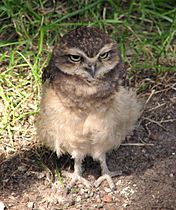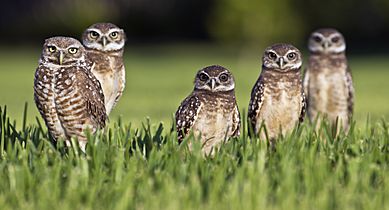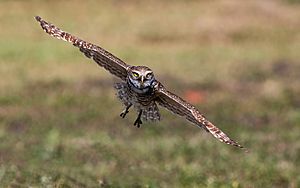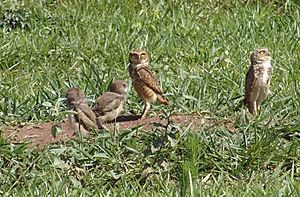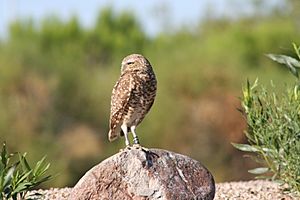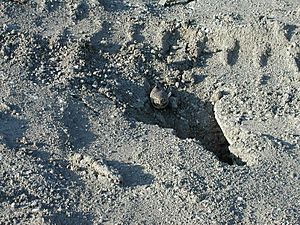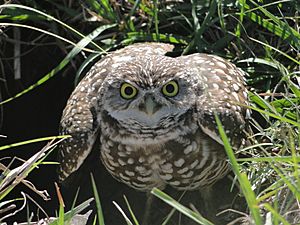Burrowing owl facts for kids
Quick facts for kids Burrowing owl |
|
|---|---|
 |
|
| Brazilian burrowing owl A. c. grallaria Pantanal, Brazil |
|
| Conservation status | |
| Scientific classification | |
| Genus: |
Athene
|
| Species: |
cunicularia
|
| Subspecies | |
|
About 20 living, see text |
|
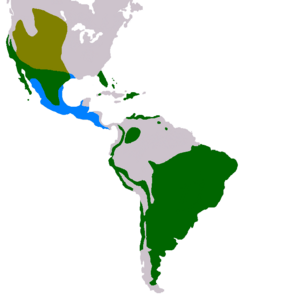 |
|
| Range of A. cunicularia Summer breeding range Winter non-breeding range Resident breeding range | |
| Synonyms | |
|
Strix cunicularia Molina, 1782 |
|
The burrowing owl (Athene cunicularia), also called the shoco, is a small, long-legged owl found throughout open landscapes of North and South America. Burrowing owls can be found in grasslands, rangelands, agricultural areas, deserts, or any other open, dry area with low vegetation. They nest and roost in burrows, such as those excavated by prairie dogs (Cynomys spp.). Unlike most owls, burrowing owls are often active during the day, although they tend to avoid the midday heat. Like many other kinds of owls, though, burrowing owls do most of their hunting during dusk and dawn, when they can use their night vision and hearing to their advantage. Living in open grasslands as opposed to forests, the burrowing owl has developed longer legs that enable it to sprint, as well as fly, when hunting.
Contents
Taxonomy
The burrowing owl was formally described by Spanish naturalist Juan Ignacio Molina in 1782. The burrowing owl is now placed in the genus Athene that was introduced by German zoologist Friedrich Boie in 1822.
There are 18 recognised subspecies, of which two are now extinct.
-
Brazilian burrowing owl (A. c. grallaria)
Jaú (São Paulo, Brazil)
Description
Burrowing owls have bright eyes; their beaks can be dark yellow or gray depending on the subspecies. They lack ear tufts and have a flattened facial disc. The owls have prominent white eyebrows and a white "chin" patch which they expand and display during certain behaviors, such as a bobbing of the head when agitated.
Adults have brown heads and wings with white spotting. Their chests and abdomens are white with variable brown spotting or barring, also depending on the subspecies. Juvenile owls are similar in appearance, but they lack most of the white spotting above and brown barring below. The juveniles have a buff bar across their upper wings and their breasts may be buff-colored rather than white. Burrowing owls of all ages have grayish legs longer than those of other owls.
Males and females are similar in size and appearance, so display little sexual dimorphism. Females tend to be heavier, but males tend to have longer linear measurements (wing length, tail length, etc.). Adult males appear lighter in color than females because they spend more time outside the burrow during daylight, and their feathers become "sun-bleached". The burrowing owl measures 19–28 cm (7–11 in) long and spans 50.8–61 cm (20–24 in) across the wings, and weighs 140–240 g (5–8 oz). As a size comparison, an average adult is slightly larger than an American robin (Turdus migratorius).
Distribution and habitat
Before European colonization, burrowing owls probably inhabited every suitable area of the New World, but in North America, they have experienced some restrictions in distribution since then. In parts of South America, they are expanding their range due to deforestation. The western burrowing owls (A. c. hypugaea) are most common in the Rocky Mountain Arsenal National Wildlife Refuge, as well as in most of the western states. Known resident populations inhabit areas of Colorado, Arizona, New Mexico, Texas and California, where their population is reportedly threatened by human encroachment and construction.
Burrowing owls range from the southern portions of the western Canadian provinces (British Columbia, Alberta, Saskatchewan, Manitoba) and all the way through Mexico to western Panamá. They are also found across the state of Florida, as well as some Caribbean islands. In South America, they are fairly common, and are known to inhabit every country on the continent, with the exception of the dense Amazon rainforest interior and the highest ranges of the Andes Mountains. Their preference is for the cooler, possibly sub-tropical coastal and temperate regions. South of the Amazon, their population seems to again rebound, as they are widely distributed from southern Brazil and the Pantanal down to Patagonia and Tierra del Fuego.
Burrowing owls are year-round residents in most of their range. Birds that breed in Canada and the northern U.S. usually migrate south to Mexico and the southern U.S. during winter months.
Behaviour and ecology
This species can live for at least 9 years in the wild and over 10 years in captivity. They are often killed by vehicles when crossing roads, and have many natural enemies, including badgers, coyotes, and snakes. They are also killed by both feral and domestic cats and dogs. Two birds studied in the Parque Nacional de La Macarena of Colombia were free of blood parasites.
Burrowing owls often nest and roost in the burrows made by ground squirrels, a strategy also used by rattlesnakes. When threatened, the owl retreats to the burrow and produces rattling and hissing sounds similar to those of a rattlesnake. The behavior is suggested to be an example of acoustic Batesian mimicry and has been observed to be an effective strategy against animals that are familiar with the dangers posed by rattlesnakes.
Breeding
The nesting season begins in late March or April in North America. Burrowing owls usually only have one mate but occasionally a male will have two mates. Pairs of owls will sometimes nest in loose colonies. Their typical breeding habitat is open grassland or prairie, but they can occasionally adapt to other open areas like airports, golf courses, and agricultural fields. Burrowing owls are slightly tolerant of human presence, often nesting near roads, farms, homes, and regularly maintained irrigation canals.
The owls nest in a burrow, hence the name burrowing owl. If burrows are unavailable and the soil is not hard or rocky, the owls may excavate their own. Burrowing owls will also nest in shallow, underground, man-made structures that have easy access to the surface.
During the nesting season, burrowing owls will collect a wide variety of materials to line their nest, some of which are left around the entrance to the burrow. The most common material is mammal dung, usually from cattle. At one time it was thought that the dung helped to mask the scent of the juvenile owls, but researchers now believe the dung helps to control the microclimate inside the burrow and to attract insects, which the owls may eat.
The female lays an egg every one or two days until she has completed a clutch, which can consist of four to 12 eggs (usually 9). She then incubates the eggs for 3–4 weeks while the male brings her food. After the eggs hatch, both parents feed the chicks. Four weeks after hatching, the chicks can make short flights and begin leaving the nest burrow. The parents still help feed the chicks for 1–3 months.
Site fidelity rates appear to vary among populations. In some locations, owls will frequently reuse a nest several years in a row. Owls in migratory northern populations are less likely to return to the same burrow every year. Also, as with many other birds, the female owls are more likely to disperse to a different site than are male owls.
Food and feeding
When hunting, they wait on a perch until they spot prey. Then, they swoop down on prey or fly up to catch insects in flight. Sometimes, they chase prey on foot across the ground. The highly variable diet includes invertebrates and small vertebrates, which make up roughly one third and two thirds of the diet, respectively. Burrowing owls mainly eat large insects and small rodents. Although burrowing owls often live close to ground squirrels (Marmotini), they rarely prey upon them. They also hunt bats. An analysis of burrowing owl diets in the Dominican Republic found the owls consumed ~53% invertebrates, ~28% other birds, ~15% reptiles, ~3% amphibians, and 1% mammals.
Rodent prey is usually dominated by locally superabundant species, like the delicate vesper mouse (Calomys tener) in southern Brazil. Among squamates and amphibians, small lizards like the tropical house gecko (Hemidactylus mabouia), snakes, and frogs and toads predominate. Generally, most vertebrate prey is in the weight class of several grams per individual. The largest prey are usually birds, such as eared doves (Zenaida auriculata) which may weigh almost as much as a burrowing owl, as well as sparrows.
Regarding invertebrates, the burrowing owl seems less of a generalist. It is extremely fond of termites such as Termitidae, and Orthoptera such as Conocephalinae and Copiphorinae katydids, Jerusalem crickets (Stenopelmatidae), true crickets (Gryllidae) and grasshoppers. Bothynus and Dichotomius anaglypticus scarab beetles (Scarabaeidae) were eaten far more often than even closely related species by many burrowing owls across central São Paulo (Brazil). Similarly, it was noted that among scorpions Bothriuridae were much preferred, among spiders Lycosidae (wolf spiders), and among millipedes (Diplopoda) certain Diplocheta. Small ground beetles (Carabidae) are eaten in quantity, while larger ones are much less popular as burrowing owl food, perhaps due to the vigorous defense the large species can put up. Earthworms are also preyed upon. Burrowing owls are also known to place the fecal matter of large herbivorous mammals around the outside of their burrows to attract dung beetles, which are used to provide a steady source of food for the owls. Burrowing owls can also predate on invertebrates attracted to artificial night lighting.
Unlike other owls, they also eat fruits and seeds, especially the fruit of tasajillo (Cylindropuntia leptocaulis) and other prickly pear and cholla cacti. On Clarion Island, where mammalian prey is lacking, they feed essentially on crickets and prickly pear fruit, adding Clarión wrens (Troglodytes tanneri) and young Clarion mourning doves (Zenaida macroura clarionensis) on occasion.
Status and conservation
The burrowing owl is endangered in Canada and threatened in Mexico. It is a state threatened species in Colorado and Florida and a California species of special concern. It is common and widespread in open regions of many Neotropical countries, where they sometimes even inhabit fields and parks in cities. In regions bordering the Amazon Rainforest they are spreading with deforestation. It is therefore listed as Least Concern on the IUCN Red List. Burrowing owls are protected under the Migratory Bird Treaty Act in Canada, the United States, and Mexico. They are also included in CITES Appendix II. NatureServe lists the species as Apparently Secure.
Dependency on burrowing animals
The major reasons for declining populations in North America are loss of habitat, and control programs for prairie dogs. While some species of burrowing owl can dig their own burrows, most species rely on burrowing animals to burrow holes that the owls can use as shelter and nesting space. There is a high correlation between the location of burrowing animal colonies, like those of ground squirrels, with the presence of burrowing owls. Rates of burrowing owl decline have also been shown to correlate with prairie dog decline. Western burrowing owls, for example, nest in burrows made by black-tailed prairie dogs since they are unable to dig their own. However, prairie dog populations have experienced a decline, one of the causes of this being prairie dog eradication programs. When prairie dogs dig burrows, they can uproot plants in the process. This is most common in agricultural areas, where burrows cause damage to existing crops, creating a problem for local farmers. In Nebraska and Montana, eradication programs have already been put in place to manage the population of prairie dogs. Eradication programs for ground squirrels have also been put in place. In California, California ground squirrels have been known to feed on crop seedlings as well as grasses meant for cattle, which prevents crop growth and decreases food supply for cattle. However, as burrowing animal populations decrease, burrowing owls become more vulnerable to exposure to predators. With fewer burrows available, burrowing owl populations will be more concentrated, with more owls occupying fewer burrows . As a result, predators will more easily detect owl populations and be capable of eliminating larger broods of owls at once. Prairie dogs and ground squirrels also act as a buffer between owls and their predators, since they become the target prey rather than the owls. Another benefit prairie dogs in particular provide burrowing owls takes the form of their alarm calls, which alert burrowing owls if predators are nearby, therefore giving the owls ample time to hide or escape. Without burrowing animals, almost every aspect contributing to suitable and safe living for burrowing owls will no longer be available. Organizations have tried contributing to the conservation of burrowing owls by digging artificial burrows for these owls to occupy in areas with no active colony of burrowing animals. However, creating artificial burrows is not sustainable and is not effective as a long term solution.
Anthropogenic impacts
Burrowing owls readily inhabit some anthropogenic landscapes, such as airport grasslands or golf courses, and are known to take advantage of artificial nest sites (plastic burrows with tubing for the entrance) and perches. Burrowing owls have demonstrated similar reproductive success in rural grasslands and urban settings. The urban-residing burrowing owls have also developed the behavior of digging their own burrows and exhibit different fear responses to human and domestic dogs compared to their rural counterparts. Research has suggested that this species has made adaptations to the rapid urbanization of their usual habitat, and conservation efforts should be considered accordingly. Genetic analysis of the two North American subspecies indicates that inbreeding is not a problem within those populations.
Relocation
Where the presence of burrowing owls conflicts with development interests, a passive relocation technique has been applied successfully: rather than capturing the birds and transporting them to a new site (which may be stressful and prone to failure), the owls are half-coerced, half-enticed to move on their own accord. The preparations need to start several months prior to the anticipated disturbance with observing the owl colony and noting especially their local movements and site preferences. After choosing a location nearby that has suitable ground and provides good burrowing owl breeding habitat, this new site is enhanced by adding burrows, perches, etc. Once the owls have accustomed to the changes and are found to be interested in the location – if possible, this should be at the onset of spring, before the breeding season starts – they are prevented from entering the old burrows. A simple one-way trapdoor design has been described that is placed over the burrow for this purpose. If everything has been correctly prepared, the owl colony will move over to the new site in the course of a few nights at most. It will need to be monitored occasionally for the following months or until the major human construction nearby has ended.
See also
 In Spanish: Athene cunicularia para niños
In Spanish: Athene cunicularia para niños





